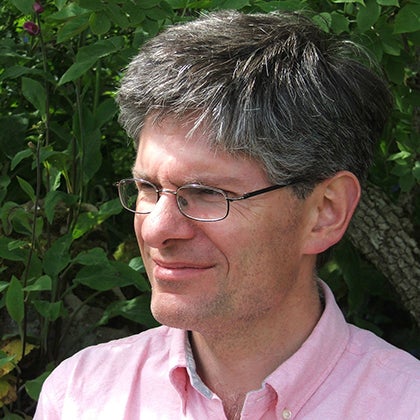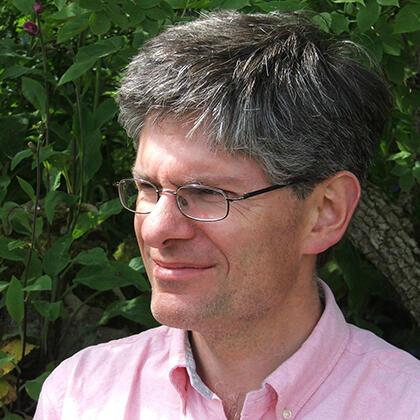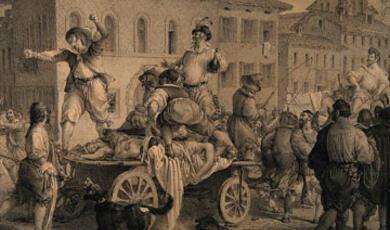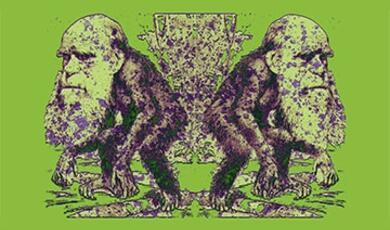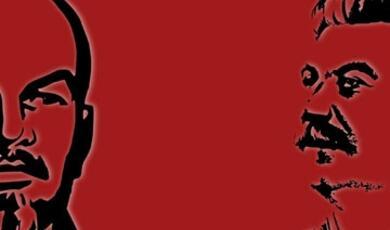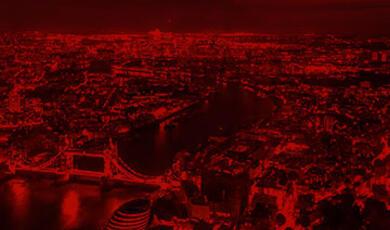What Would Jesus Do? Christian Culture Wars in the Modern West
Share
- Details
- Transcript
- Audio
- Downloads
- Extra Reading
Christian Culture Wars in the Modern West Europe and North America are now marginal in global Protestant Christianity, but they remain the vital test-bed of how this religion and post-industrial society can, or cannot, adapt to each other. This lecture will explain how, following the moral trauma of the Second World War, Christianity has produced both a bold, sometimes self-defeating liberalism, and also a newly assured but politically compromised conservatism; and explore the deep continuities connecting the two, and how they continue to shape the contemporary world.
Download Transcript
14 April 2016
What Would Jesus Do?
Christian Culture Wars in the Modern West
Professor Alec Ryrie
You will likely have come across the phrase ‘What Would Jesus Do?’ which has become a cliché of evangelical Protestant usage in modern America and beyond. The four-letter summary has become ubiquitous – the wristband is maybe the best-known symbol. But there has been a movie, with a couple of sequels; there are T-shirts, not all of them fully on-message; there are items which I suspect are designed and sold with some sense of irony; and there are numerous attempts to take this evangelical cliché in other directions, of which this is one of my favourites.
This is all good clean fun, but I want to suggest today that it’s of some value in thinking about the history of Protestantism in the modern west, the current era of decline in Protestantism’s old European and North American heartlands even as it is expanding rapidly in other parts of the world. Because this actual question, what would Jesus do, is a relatively novel one, which many previous generations of Christians would have seen as misleading or inappropriate: it has been asked with sharp urgency by Christians in the modern west for much of the past century or more; and it has produced radically divergent answers. I think it helps to shed some light on that story of decline. The widely held view that this has been about inevitable modern secularisation and scepticism, a story which has been being told since the eighteenth century but whose timetable keeps having to be extended. I am going to suggest that it is much more to do with politics, and in particular with the impact of the defining moral event of our age, that is, the Second World War – the war which provided the modern age’s working definition of evil.
That war marked a resurgence of sorts for the self-consciously Christian identity of the western Allies. For some in Britain and, more especially, the United States, it was a war for Christian civilisation against barbarism. When the United States entered the war in 1941, cheered on by interventionist Protestants, it portrayed its struggle as a holy war. It honoured America’s foundational separation between church and state by rolling together the only three religious groups which mattered into a newly imagined entity called ‘Judeo-Christian civilisation’. American soldiers were free to be Protestants, Catholics or Jews, but it was assumed they would be one or the other. And the American armed forces provided a more intensive and better resourced ecumenical chaplaincy than any mass army in human history has ever done. Nazi Germany’s military chaplains were marginalised and despised; the United States’ were exalted. The sixteen million Americans who served in the armed forces during the 1940s – 80% of the men born during the 1920s – were graduates of a unique military-ecclesiastical complex.
One incident came to symbolise America’s crusade. In February 1943, the American troop ship Dorchester was torpedoed off the Canadian coast. Four chaplains – two Protestants, a Catholic and a Jew – worked together to hurry men into lifeboats, then distributed lifejackets. When the lifejackets ran out, they gave their own to four young soldiers. They then joined hands and sang and prayed together as the ship sank. Reportedly they were reciting the Shema, the Jewish affirmation of God’s oneness, as the waters took them. The ‘Four Chaplains’ became symbols of a Judeo-Christian America united against its godless foes. American soldiers were told so often that Nazism was anti-Christian that, when they entered Germany, many expressed surprised that church buildings still stood there.
This was not the first or the last time wartime propaganda has painted itself with the cross, and plenty of Americans were cynical about it. Paul Fussell’s famously acerbic memoir of wartime service recalled how when the term ‘crusade’ was used, most GIs ‘sneered or giggled’. But as it happened, the joke went sour. Allied troops in Germany discovered more than just churches. Even if they had believed everything they had heard about concentration camps, nothing could have prepared them for what they found at Buchenwald and Dachau. Eisenhower, promising vainly to discipline the soldiers who, in their horror, had summarily shot dozens of SS officers at Dachau, reflected, ‘We are told that the American soldier does not know what he is fighting for. Now at least he will know what he is fighting against.’ Fussell agreed that this was where cynicism died:
They had seen and smelled the death camps, and now they were able to realize that all along they had been ... fighting for something positive, the sacredness of life itself. ... After the camps, a moral attitude was rampant. ... The boys’ explosive little tour in France had been a crusade after all.
Every Christian army tells its soldiers they are fighting the forces of evil. Just this once, it turned out to be true.
So 1945 was a moment of hope for what still thought of itself as the Christian West. Only Judeo-Christian civilisation had had the moral power to defeat Fascism, and only Judeo-Christian civilisation had the moral power to confront Communism. The political centre-right in most of post-war Europe was dominated by new Christian Democratic parties, uniting Catholics and Protestants. In Britain, one of the intellectual architects on the postwar settlement was Archbishop William Temple, also a pioneer of Anglican-Jewish reconciliation. This surge of Christian politics was not exactly matched by religious revival, but there was a modest uptick even in Europe, and in America the change was unmistakable. In 1954 the United States added the phrase ‘under God’ to the Pledge of Allegiance, and adopted ‘In God We Trust’ as a national motto. This was more than a hope that religion could bolster the fight against Communism: it was recognition of a reality. The previous year, the proportion of the US population who were formal members of a church reached its highest ever level, 59.5%. Polling indicated that the American public respected religious leaders far more than any other group in their society, a dramatic turnaround from the pre-war years. Weekly church and synagogue attendance in the US rose from 38% in 1946 to 49% in 1955. Bible sales doubled over the same period. As importantly, the two long-alienated halves of American Protestantism seemed to be coming back together. The clerical and intellectual elite, and the evangelicals and fundamentalists whom the elite had thought had disappeared in the 1920s but had in fact simply built up their own redoubts, began to engage with each other again. Billy Graham, a man whom it proved impossible for anyone to dislike, even if they tried, was the symbol of this: he brought evangelicals out of their defensive crouch and persuaded both evangelicals and establishment that they could and should work together.
We can almost imagine that it could have lasted. But the western democracies in the 1950s were not waking from a ghastly secularist-totalitarian nightmare. They were doing their best to subside back into a pleasant dream from which they had been roughly awoken. We can hardly blame them. After the Second World War a certain numbness was only natural. But before too long its lessons would need to be absorbed in earnest.
That meant doing more than simply restating old religious truths. Since the previous century some Christians had been wondering if God was calling them, not to sing the old gospel in a different key, but to play a different tune altogether. So churches, hierarchies, liturgies, sacraments and all that were declining: perhaps this was God’s will, and Christians should allow them to die, or even kill them!, rather than preserving them on life support? Jesus Christ, after all, was no friend of hierarchies. In the 1880s, the campaigning British journalist W. T. Stead experienced a conversion in which God told him to ‘be no longer a Christian, be a Christ’. The question how should a Christian live now became the subtly different what would Jesus do. In an 1894 pamphlet If Christ Came to Chicago!, a bestseller on both sides of the Atlantic, he argued that was Jesus would do in that iconic modern city was found what he called a Civic Church, which would serve all humanity regardless of race, gender or religion, and would be open to anyone willing to work selflessly for the common good. The measure of true Christianity was not churchiness, but ‘the extent to which we succeed in restoring in man the lost image of God’. Many of his contemporaries struggled to see how ‘being a Christ’ like this actually spread the Gospel. It would surely be better, as one critic put it, ‘if Chicago came to Christ’. But the idea did not go away.
In the summer of 1944, strikingly similar ideas were pressing on the conscience of Dietrich Bonhoeffer, the brilliant aristocratic German Lutheran who was one of the first to see Nazism for what it was, and who in 1945 was hanged for his involvement in a failed plot to assassinate Hitler. During 1944, in prison in Berlin as the bombs fell around him, with all trace of Christian civilisation apparently gone, Bonhoeffer began groping towards an understanding of what Christian faith might mean in this new world. Writing to a friend, he said: ‘We are proceeding towards a time of no religion at all: men as they are now simply cannot be religious anymore.’ Rather than fighting a rear-guard action against this, he wondered whether Christians might be called to work with it. Perhaps ‘religion’ was an infantile stage which ‘a world come of age’ had outgrown? What if ‘religion’ could be separated from Christianity, and is in fact no more than its ‘garment’? What would then be needed would be, as he put it, ‘a religionless Christianity’.
In a series of letters Bonhoeffer circled around the problem of what this religionless Christianity might actually be. He certainly did not mean some milk-and-water rationalisation of the faith, stripped of revelation or divine power. Rather, he hoped to strip away structures, hierarchies, forms, jargon, and anything smacking of worldly wealth or power. The aim was a truly Christlike Christianity, as weak and powerless as Christ had been, serving the world from the cross. Repeatedly in these letters, however, Bonhoeffer shied away from specifying how this could actually work. ‘I shall be writing to you about it again soon … I am thinking over the problem at present … More about that next time, I hope.’ If he made any further progress before the Nazis hanged him, his surviving letters do not record it.
Bonhoeffer’s theological reputation in the West was considerable even before it acquired the aura of martyrdom. It was cemented by the collection of his prison writings which was published in English in 1952. His inconclusive reflections on ‘religionless Christianity’ spoke profoundly to many of his British and American readers. They shared his impatience with ‘religion’, in the sense of institutionally self-interested churchiness. This new generation, like so many Protestants before them, wanted to cut through formalism and hypocrisy to rediscover the authentic heart of the Gospel. ‘Authenticity’ became their watchword: for they felt that the church-Protestantism they had inherited, and indeed the whole of the patched-together post-war society which hosted it, was a sham.
This burgeoning discontent first took shape, not in the margins or the ‘religionless’ spaces, but at the heart of western Christian privilege, the universities. Student groups were groping towards ways of living an ‘authentic’, ‘religionless’ Christian life. Joseph Wesley Matthews, a former Fundamentalist preacher whose faith had been turned upside down by the butchery of the Pacific war, had discovered Bonhoeffer, and his gospel now became a search for a ‘breakthrough’ to authenticity. He once ripped out the pages of a church Bible during a sermon, to demonstrate what breaking free of ‘religion’ might be. He became leader of a student community in Austin, Texas, where he made it his business to help the community’s members break through their self-deceptions to discover their authentic selves. It became something that they could believe passionately in. One member of the community claimed it was like the early Church restored, because, as he said, ‘the early Church didn’t give a goddamn about life after death. Neither do we.’ The claim about the early Church is entirely wrong, but the focus on this world rather than abstract pieties was true to Bonhoeffer’s vision. That deliberate profanity, using blasphemy to cut through pious conventions, was America’s own contribution.
The paradox of this movement was that it sought inner authenticity but adamantly refused to focus on inward piety. That was ‘religion’, a means of disengaging from the world. Instead, it hoped to find its true nature in Christlike service to the world, given with defiant disregard to cost. It was an awakened conscience searching for a cause to serve. It did not have to search very hard.
The struggle for African-American civil rights was a long story which America’s white churches had, until now, scarcely engaged with. That changed in 1955, when the leadership pf a campaign against segregated seating on buses in the city of Montgomery, Alabama, was thrust unexpectedly onto a 26-year-old Baptist minister named Martin Luther King, Jr. King had been raised in which he called Fundamentalism, but had studied at the heart of the mainline white churches’ establishment: his ability to connect those very different worlds, and to speak both of their languages, would be crucial to his achievement. That, and his remarkable moral and intellectual clarity. The key moment of the campaign, and perhaps of King’s entire career, was the night of 30 January 1956, less than two months into the boycott, when King’s house was bombed. He was not at home, but his wife Coretta and their two-month-old daughter were: they escaped unhurt. By the time King had hurried home from his meeting, hundreds of supporters had gathered. They came, Coretta recalled, ‘to do battle. ... It could have been a riot, a very bloody riot.’ The city’s mayor and police commissioner, trying to disperse the crowd, only stirred up their anger. Then King spoke from the bomb-damaged porch. It was not the high oratory he was capable of, but the impromptu, knife-edge words which the Montgomery Advertiser reported the following day were crystal clear:
Don’t get your weapons. He who lives by the sword will perish by the sword. ... We want to love our enemies. I want you to love our enemies. Be good to them. Love them and let them know you love them. ... If I am stopped our work will not stop. For what we are doing is right.
The reporter added that, by the time King had finished, the mayor and commissioner ‘looked very much like members of the beet family’. The crowd remained, singing hymns, for much of the rest of the night.
The eventually victory on the buses was both costly and, in itself, empty. But what King had achieved reached much further than that. He successfully claimed post-war America’s moral high ground. This was a struggle, ‘between the forces of light and the forces of darkness’, not between white and black Americans. Preaching in February 1956, he insisted:
We are concerned not merely to win justice in the busses but rather to behave in a new and different way – to be non-violent so that we may remove injustice itself, both from society and from ourselves. This is a struggle which we cannot lose, no matter what the apparent outcome, if we ourselves succeed in becoming better and more loving people.
If you want the contrast: at a segregationist rally in Montgomery earlier the same month, a handbill titled ‘A Declaration of Segregation’ was distributed, stating: ‘We hold these truths to be self-evident that all whites are created equal with certain rights; among these are life, liberty and the pursuit of dead n*****s.’ The contrast, at least for those Americans who were not themselves in a deep pit of hate and fear, could hardly be plainer.
It is worth emphasising how profoundly Christianised this movement was, from King’s testimony to his spiritual struggles, to his newly-founded organisation, the Southern Christian Leadership Conference, a body whose volunteers were required to pledge to ‘MEDITATE daily on the teachings and life of Jesus’, ‘WALK and TALK in the manner of love, for God is love’ and ‘PRAY daily to be used by God’. The civil-rights campaign had an old-fashioned revivalism to it. There were moments of prophetic certainty, claps of thunder during sermons, ministers raised from their sickbeds to preach with unaccustomed power. The greatest miracle was marching straight-backed towards brutal police and watching their power melt away. As Thomas Gilmore, who would himself become one of Alabama’s first black sheriffs, put it:
You really get the feeling that somebody bigger than you is walking beside you, and you feel that, well, man, nobody can hurt you if he wanted to.
For white campaigners, the movement offered a different revivalist trope: repentance and redemption. Civil-rights preachers named evil for what it was, challenged their hearers to slough it off, and offered them forgiveness if they did.
The message’s power across America’s churches was plain. Even the white Southern churches were largely paralysed into inactivity, despite the overwhelmingly pro-segregation views of their memberships. The evangelical establishment, represented by Billy Graham, plainly backed the cause. In 1961 one South Carolina newspaper dropped Graham’s syndicated column in protest against his integrationist views, only to be met with a surge of protest from readers who valued his gospel more than they disliked his racial politics. It was a sign that the battle was lost. As King had promised, it had been lost not in white Southerners’ segregated schools and shops, but in their hearts. Most of them still wanted segregation. But they no longer knew how to defend it nor had the will to fight for it. And so, slowly, at times bloodily, but inexorably, it ended.
But if most American Christians accepted the power of King’s message, one group in particular were entranced by it. The authenticity-seekers of the 1950s, hoping with Bonhoeffer to form a ‘religionless Christianity’, were drawn to the civil-rights movement like moths. This was – for a while – a fully-worked out demonstration of what Bonhoeffer had struggled to imagine. This was religionless Christianity in action: a movement whose Christian basis was unmistakable, but which was never about churchiness, jargon, institutions or religious cliques. It was led by Christians but not for Christians, and it welcomed allies regardless of their faith. The main student-led civil-rights organisation, the Student Nonviolent Coordinating Committee plainly looked to King’s principles and was stuffed with Christian activists, but deliberately avoided a Christian identity. This was a movement which would live the Gospel rather than boasting of it.
And of course, it worked. Civil-rights campaigning was a matter of courage and exhilaration, of sacrifice and labour, of a sense of community which transcended racial and religious barriers. It seemed much more like true Christianity than yet another self-satisfied Sunday service. The civil-rights movement was prophetic, leading the world into a new age. This was what Jesus would do: provide prophetic leadership. Unfortunately, not all self-appointed prophets succeed.
The early 1960s was a moment of heady possibilities. The post-war generation was coming of age. In 1960 the contraceptive pill was approved for general use in the United States, and obscenity prosecution against D. H. Lawrence’s Lady Chatterley’s Lover in Britain was triumphantly defeated. One of the star witnesses at the Lady Chatterley trial was the Anglican bishop John Robinson. As a chaplain at Cambridge University in the 1950s, Robinson had suspected that a Christian resurgence might be dawning. His arrival in 1959 as bishop of Woolwich was a rude awakening. His shock on meeting the English working class up close was not unlike Bonhoeffer’s shock on meeting his jailers: men of apparently utter indifferent to religion. Robinson was an avid reader of Bonhoeffer. His shocking courtroom defence of an obscene book was part of a wider effort to develop a prophetic Christian voice. He wanted to speak unexpected, riveting truths rather than always mouthing the self-serving platitudes which the public had long since learned to ignore. His bestselling 1963 book Honest to God appealed to the same ethic of authenticity. The title promised that, instead of party-line religious cant, for once a bishop was going to tell the plain truth. There wasn’t really anything very radical in the book: he took some fairly standard liberal Protestant ideas and conveyed them in vivid language for a mass readership. But of course, he called for a truly religionless Christianity.
Ominously, his call was taken up not in the secularised cities, but in his old university stamping-grounds. The story of what happened to student Christianity in the 1960s is a microcosm of the decade’s wider religious convulsions. The leading British student Christian organisation was the Student Christian Movement (SCM), whose ethic was broad, socially engaged and ecumenical. It had around 7000 members in 1963, a number which fell by a staggering 90% over the following decade. What makes this catastrophe remarkable is that it was almost deliberately self-inflicted. In 1962, the SCM’s new secretary, the veteran anti-apartheid activist and Bonhoeffer enthusiast Ambrose Reeves, introduced what he called an ‘openness policy’, committing the SCM to ignoring any distinctions between Christians and non-Christians. Christianity, Reeves argued, needed to serve the secular world rather than withdraw from it or fight it. The SCM, therefore, should be ‘primarily concerned with students who are not Christians … It may well be that we can best serve the churches by ceasing to be a “religious” society.’
This reckless, self-sacrificial abandonment of institutional self-interest certainly felt prophetic. It did not by itself answer the awkward question which Bonhoeffer had not resolved: what does a religionless Christianity actually consist of? Reeves’ answer was political struggle: working alongside groups of all kinds that were ‘seeking to promote justice and world peace’. In 1968 the SCM formally committed itself to worldwide Marxist revolution. A 1969 SCM communique refused to distinguish between revolution and the Kingdom of God. Now whether or not you agree with this policy, it had certain practical consequences. Most student Christians did not share these political views, and simply left the organisation. The SCM’s leaders, who knew that prophets are not honoured in their own time, felt vindicated by this. But for the true believers who stayed, it wasn’t clear what they were supposed to do. If all the SCM did was support secular campaigns, why did it exist at all? It was deliberately and conscientiously trying to suppress any assertion of Christian identity, and to subsume that identity into radical politics. And so Christians who disliked radical politics withdrew from the SCM, while Christians who embraced radical politics increasingly saw themselves simply as radicals and no longer as Christians. Britain’s main student Christian organisation willed itself almost out of existence.
The SCM’s story is extreme, but it was widely paralleled. The 1972 assembly of the World Student Christian Federation committed itself to ‘the common class struggle against capitalism’, passed a series of political resolutions, and deplored the failure to invite official representatives from the People’s Republic of China, where at that date Christian practice of any kind was illegal. And grown-ups were caught up in the same mood. The World Council of Churches’ assembly at Uppsala in 1968 chose the slogan, ‘The world sets the agenda’: it’s the same deliberate and conscientious refusal to assert a Christian identity. Its focus was anti-imperialism and anti-racism. In the USA the National Council of Churches moved from being a complacent establishment to, by the end of the 1960s, a prophetic political voice, campaigning on the Vietnam War and a host of other divisive issues. The point is not whether these policies were right or not, but that those organisations were presuming to lead their member churches in a radical direction without heed to ordinary believers’ views. They were there to serve the world, not their own flocks. It’s what Jesus would have done. No wonder some of these radicals contemplated what Bishop Robinson called, sympathetically, ‘creative disaffiliation’ from the Church. Sometimes, Robinson said, ‘non-involvement in organized religion is indeed a Christian vocation’. He may have had his American friend James Pike in mind: the Episcopalian bishop of California who had grown increasingly contemptuous of what he called the ‘standard-brand churches’ and their obsession with irrelevant doctrines. Pike resigned his bishopric in 1966 and in 1969 left the Church altogether to form what he called a ‘Foundation for Religious Transition’. Its aim was to uncover the true Jesus, who was of course a political revolutionary. In the same year Pike travelled to Israel, confident that he would make ‘the big breakthrough’ to the new post-religious consciousness. Instead, he and his young, third wife became lost in the Judean desert. She found her way to safety. His body was found a few days later. It was perhaps a kind of prophetic end, although not of the sort he had intended.
Western Protestantism would in any case have faced powerful cultural headwinds in the 1960s. But its fateful seduction by a half-developed idea of religionless Christianity made matters much, much worse. A swathe of Christians became convinced that it was their Christian duty to stop talking about Christianity and to subsume themselves into radical politics. Some completed the journey and became simple revolutionaries. Many others discovered that being a religionless Christian was pretty much like being an ordinary secular citizen. They joined the large majority of the population who professed a Christian identity but showed little sign of it in their everyday lives. Others remained in the churches with a sense of voiceless disillusion. No doubt they deserved prophetic denunciation, but they did not enjoy it. As for wider society, Protestant leaders were telling everyone that churches were unimportant. Unsurprisingly, it was a message many people were ready to hear.
Bonhoeffer knew that he hadn’t worked out what form ‘religionless Christianity’ might take. He did not know that his half-formed musings in private letters would be turned into a manifesto. He also did not know that the future was not going to be as inhuman as it looked from a Berlin prison in 1944. In retrospect, one feature of that prison environment stands out: the guards and prisoners whose irreligion so shook Bonhoeffer were all men. Christianity across most of the world, for at least the last two and a half centuries, has been predominantly a women’s religion. Patriarchal Christians have often worried that this makes Christianity seem weak. One of the reasons that Bonhoeffer worried that religion was irrelevant was that so many religious people were women. Women were the backbone of the modest revival of the 1950s. Yet the prophets of religionless Christianity, like almost all of the prophets of 1960s radicalism, were men, and their quest for revolutionary relevance was a very masculine agenda. Religionless Christianity turned out, in practice, not only to be a denial of the mundane lived reality which makes a sustained Christian community possible, but also a repudiation of many of the unglamorous, faithful pew-fillers who were more often treated with disdain than recognised as that community’s life-blood.
By 1970 it was already clear that establishment Protestant churches were in free fall, with the Catholics not far behind. And in those churches, the downward trajectory has been maintained ever since, with some variations and pockets of good news. Whether the tide can at some point turn for these institutions is another matter. It has often done so before, and there is no such thing as an unstoppable historical force, but at present there’s not much sign of it. And for western European Protestantism, dominated as it is by those establishment churches, this is the bulk of the story, although even here, some conservative and even fundamentalist churches have fared less badly. In the United States, of course, things have been different.
By the early 1970s, it was becoming plain that while theologically and politically radical American Protestants had dug themselves into a hole, their evangelical and fundamentalist brethren were relatively unscathed. The bestselling book of the 1970s in America was Hal Lindsey’s The Late, Great Planet Earth, whose space-age title belied its very traditional set of apocalyptic predictions. But those predictions themselves, alarming as they were, didn’t settle the question of the political flavour that this resurgent evangelicalism would have. And indeed, it initially looked as if it would tug to the Left.
During the 1976 presidential election, with the Republican party’s moral authority in shreds after Watergate, a Democratic candidate emerged who was, unprecedently, a bona fide, born-again evangelical. Jimmy Carter’s election poster was not meant to be taken entirely seriously, but says something about the hopes invested in him. A flood of political novices volunteered for Carter, and unusually high primary turnouts helped him to clinch the Democratic nomination. The televangelist Pat Robertson had Carter as a guest on his show, and later said that ‘Carter was the one who activated me and a lot of others’. Carter’s eventual election victory depended on the fact that, unprecedentedly for a Democrat, he had won more than half of the evangelical vote. The new religious Left was on the march.
But as you may be aware, it hasn’t worked out that way. In 1980, five million evangelical voters switched from Carter to the divorcé Ronald Reagan. Since then there has been a lot of attention given to the religious Right, but much less to an at least equally surprising phenomenon: the absence, or rather the invisibility, of the religious Left. Despite the fact that many American Christians have political concerns associated with the Left, repeated attempts to mould an organised, vocal religious Left have run into the sand. The result has been a strong impression that, as one junior Republican congressman bluntly put it this past January, ‘we,’ the Republican Party, ‘own the entire [Biblical] tradition’. That produced a predictable surge of confected outrage, but the real problem with that claim isn’t its arrogance but the fact that it seems so nearly true in American public life. For the fortunes of American Protestantism, being associated exclusively with one political party is a dangerous place to be, even if that party weren’t currently tearing itself to pieces.
The story of the religious Left’s disarray during and after the Carter presidency suggests that it foundered on one immediately presenting problem, which was itself a symptom of deeper, more intractable difficulties. That problem was abortion, which was legalised throughout the United States by a Supreme Court decision in 1973. As the meaning of that decision sunk in, and as the scale of legal abortion became clear, Christians of all political persuasions discovered in themselves an apparently intuitive moral revulsion at it, despite the lack of direct Biblical guidance on the practice. For Christians on the political Right, it became a rallying point. But on the Left it was much harder. The campaign for legal abortion was a feminist cause. Feminism was part both of the Democratic party’s coalition and of its identity. Left-leaning Christians found themselves torn between pro-feminist and anti-abortion impulses, none more so than Carter himself. He did not conceal his own personal disagreement with the court’s decision. He supported excluding abortion from Medicaid, and he appointed an anti-abortion Catholic as health secretary. Yet he also refused actively to campaign against abortion. The bulk of his staff were, in the emerging jargon, ‘pro-choice’, a position which was strongly endorsed in the party’s 1980 platform. A major core Democratic constituency found his anti-abortion views increasingly unacceptable, whereas evangelical (and Catholic) voters felt he had betrayed them. The joke in 1980’s evangelical election slogan was bitterer than four years earlier: ‘Abort Carter’.
There were attempts to resolve the Christian Left’s dilemma on the issue, like the campaign group JustLife in 1984, which tied the anti-abortion campaign to other ‘pro-life’ causes such as opposition to militarism and the death penalty. It attracted a good deal of publicity, but raised relatively little money and did not have much success in defending its candidates. It is not simply that the anti-abortion message was powerfully opposed in the Democratic establishment. Anti-abortion Democrats were wary of pressing their view, lest they undermine the feminist cause in which they also believed. They advanced their beliefs tentatively, with nuance and moderation. Which has never been the way to get yourself heard in American politics.
This debate was only a sign of a deeper, systemic problem: the inability of the white Christian Left to assert their religious identity. They have been muzzled not by secularist opponents, but by their own profound commitment to inclusion and opposition to discrimination. Their aim is to serve society as a whole rather than their own narrow confessional self-interest, a commitment which blends a noble Bonhoefferian instinct for self-sacrificial service with a lingering sense of white, Protestant America as normative America, which cannot abandon its universal responsibilities by claiming a particular identity for itself. So the powerful and politically active black Protestant churches are pigeonholed as black rather than as Protestant. And white Protestant America has been subsumed first into ‘Judeo-Christian’ America, then into multi- and non-faith America, making it very hard for white Protestants on the Left unapologetically to put their faith at the centre of their politics.
Take, for example, the 1980s campaign against President Reagan’s support for the Nicaraguan Contras. Over 80,000 Americans signed a Pledge of Resistance, vowing a mass campaign of nonviolent resistance in the event of direct American intervention in Nicaragua. The Pledge was an evangelical initiative, but its religious identity was quickly abandoned. If Jews or gay rights activists were to support it, naturally it could not be assertively Christian, nor could its campaign meetings include Christian prayer. Or there was the Witness for Peace movement, an extraordinarily courageous programme which placed over four thousand unarmed Americans in Nicaraguan villages at risk of Contra attack as human shields. Again it was initially an evangelical movement. But what of other sympathisers who wanted to join in? So it was broadened to being a ‘prayerful, biblically based community’ open to anyone who was ‘comfortable’ with that ethos. As it widened inexorably, drawing in liberal Protestants, Catholics, and secular idealists, the ethos was progressively diluted. One frustrated evangelical described how embracing diversity could sap the movement’s effectiveness. ‘The last thing you want to be doing when people you love are getting killed is worrying about whether your prayer is going to offend someone.’ Yet the fear that prayer might offend had become one of the facts with which the Christian Left had to live.
As one senior Democratic party strategist said in 2015, ‘the right wing has no problem using religious language to push its agenda, but liberal faith leaders hesitate to use religious language when speaking with secular coalition partners’. It is true, but it is not because Protestants on the Left lack conviction or courage. It is precisely that their convictions, often courageously held, make it intensely difficult for them to assert their religious identity.
So, for example, Martin Luther King, Jr, is remembered and celebrated as the leader of a secular coalition and a hero of civil rights, rather than for being what he also was: twentieth-century America’s greatest Christian leader and Christian martyr. And this is not a failure. It’s deliberate, and done for the best of reasons. King is and should be a unifying figure, whose moral authority transcends his own religious identity, who belongs not to the churches but to the ages.
In the meantime, the churches of the West are adrift. Those who are on both the theological and the political Right can still assert themselves, often as a counterculture, and they do so especially in the United States, where theological conservatism is far stronger and establishment church hierarchies far weaker. The rest cannot find their voice. The problem is not some inexorable deep-historical force of secularisation, but the ongoing impact of the political shock of the 1960s, itself ultimately the result of the moral shock of World War II.
The most remarkable symbol of this comes from the 1960s’ greatest adventure: the space programme. The idea of reaching to the heavens in order peacefully to defeat godless Communism should have been a gift to Christians. It was in this spirit that, on Christmas Eve 1968, the crew of Apollo 8, who were orbiting the moon and looking back at the Earth, read the first ten verses of the book of Genesis in a live television broadcast. This prompted a lawsuit from a secularist campaigner who alleged that NASA was violating the constitutional separation of church and state. The case was dismissed, but it had its effects. One of the first two men to land on the moon the following July, Buzz Aldrin, was a Presbyterian elder as well as an astronaut, and he had brought consecrated bread and wine from his home church. And so, before either he or Neil Armstrong went outside, the first food and drink ever consumed on the moon was a Presbyterian Eucharist. (Armstrong did not receive.) The real significance of this event, however, is the discretion that surrounded it. Aldrin wanted to broadcast it, like his predecessors on Apollo 8, but NASA’s flight operations manager discouraged him, wanting to avoid any further controversy. Aldrin therefore invited ‘each person listening in, wherever and whomever he may be, to contemplate for a moment ... and to give thanks in his own individual way’, and then closed down the radio to celebrate his communion. This is not, however, a story of secularist bullying. Aldrin wrote about how much the event had meant to him, but also, years later, wondered whether he had been right to do it at all:
Perhaps if I had it to do over again, I would not choose to celebrate communion. Although it was a deeply meaningful experience for me, it was a Christian sacrament, and we had come to the moon in the name of all mankind—be they Christians, Jews, Muslims, animists, agnostics, or atheists.
An earnest and committed Protestant could now feel that he had a duty to speak in the name of all humanity, and therefore, as a matter of conscience, regret privately celebrating the central rite of his faith. Who knows if that, too, is what Jesus would have done?
It may be that, as white Americans and Europeans slowly come to terms with the traumatic fact that their (our) cultural hegemony is over, they will discover a way to be genuinely pluralist while still having an identity of their own. If Protestants, or indeed the ‘Judeo-Christian’ religions as a group, can find a way of asserting their religion’s meaning and power while fully maintaining their hard-won commitment to a genuinely inclusive society, then a new chapter in the history of religion in the West, and indeed in modern societies as a whole, will begin. It may be that the slow crisis of legitimacy unfolding in the western democracies, marked by an increasingly contemptuous withdrawal from a moribund and transactional political culture, will provide an opening for one of Protestantism’s most recurrent forms, fastidious withdrawal from political life by prioritising the spiritual: this is certainly what Pentecostalism is doing in much of the world. But if there is one thing that the experience of the Christian Left in the twentieth century tells us, it is that trying to guess the future in order to steal a march on history is a risky game.
© Professor Alec Ryrie, 2016
This event was on Thu, 14 Apr 2016
Support Gresham
Gresham College has offered an outstanding education to the public free of charge for over 400 years. Today, Gresham plays an important role in fostering a love of learning and a greater understanding of ourselves and the world around us. Your donation will help to widen our reach and to broaden our audience, allowing more people to benefit from a high-quality education from some of the brightest minds.


 Login
Login




